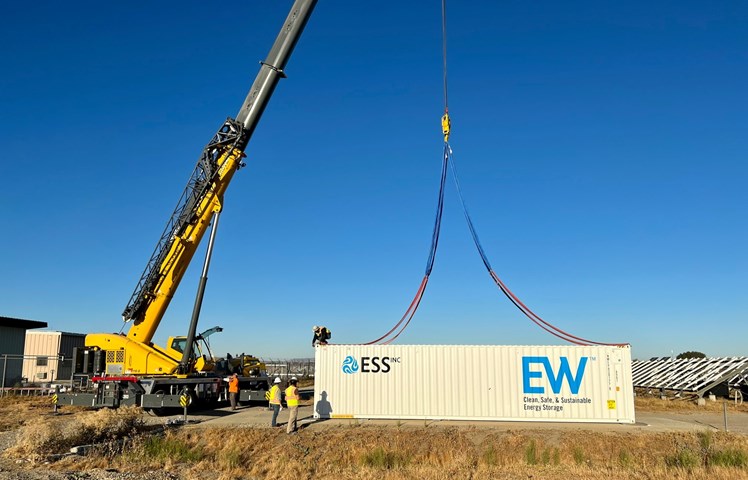ESS-SoftBank battery deal heralds a new Iron Age
The deployment of iron flow storage technology at scale represents an important energy transition milestone
1 minute read
The energy transition has taken a leap forward with the announcement of a major US$300 million deal to deploy iron flow batteries commercially at scale in the U.S.
SB Energy, a wholly owned U.S. subsidiary of Japanese financial services group SoftBank, has confirmed a record purchase of long-duration iron flow batteries from U.S. manufacturer ESS. The batteries will help enhance grid resiliency by providing long-duration storage for solar energy in utility-scale projects across Texas and California.
The deal involves a commitment by SB Energy to deploy two gigawatt-hours of ESS batteries over the next five years. The batteries use iron, salt and water to provide a low-cost, environmentally sustainable alternative to lithium-ion cells. At the same time, their composition inherently eliminates the fire risk presented by lithium-ion batteries, particularly in wildfire-prone areas such as California.
SB Energy's first ESS battery system has been delivered to a site in the Golden State and will be commissioned later this month.
“Long-duration storage is absolutely critical to providing flexible, affordable renewable energy at scale,” said Rich Hossfeld, Co-Chief Executive Officer at SB Energy, commenting on the news. “It aligns perfectly with the Biden administration’s ambitious clean energy initiatives.”
“It is undeniable that the energy storage market is poised for tremendous growth in 2021 and beyond. We see this news as another major signal of the market’s rapid acceleration.”
A simple, cheap alternative
ESS is currently the only company manufacturing iron flow batteries for commercial and utility-scale applications. It says a key strength of the batteries lies in their simplicity, which makes them a far cheaper alternative to lithium-ion cells. Each battery is a closed-loop system with four basic components: two electrodes, a separator that prevents the electrodes from forming a short circuit, and the same liquid electrolyte solution to both charge and discharge electrons. According to ESS, this arrangement keeps the battery’s chemistry stable, eliminating cross-contamination and degradation.
Flexible and recyclable
The result is a long-duration storage solution which is not only cheap to make but flexible and cost-efficient to run. ESS specifies an operating life of over 20,000 cycles, equivalent to more than 20 years of expected use. (For comparison, conventional battery chemistries have a 7-to-10-year lifecycle.) What’s more, since iron flow batteries don’t use toxic rare-earth minerals like vanadium and lithium, they cause far less environmental harm in production and can be easily broken down and substantially recycled at the end of their lives. A further advantage is that battery capacity can be expanded by adding electrolyte solution at a low marginal cost, reducing the need to buy additional units.
Maximum storage time is 12 hours — sufficient to enable a solar plant in sunny California to provide 24-hour electricity (although utilities will eventually need batteries that can last far longer). One disadvantage is the batteries’ size relative to lithium-ion. But that’s an issue for applications such as electric vehicles or mobile phones and not a barrier for grid-scale applications such as power plants.
“Long-duration batteries represent a major opportunity when it comes to achieving ambitious decarbonisation goals. As the energy transition continues to drive concerns about grid reliability and resiliency, we view long-duration batteries as being crucial to the power sector’s ability to fully transition.”
Global developers lead the iron flow charge
SoftBank is not the only major player helping to kick-start the iron flow revolution. The SB Energy deal comes hot on the heels of an order from Enel Green Power España for ESS to supply 17 of its Energy WarehouseTM battery systems with a combined capacity of 8.5 MWh. The batteries will provide long-duration storage to support a solar farm in Spain and provide resilience for the local power grid as part of a broader EU-wide engagement.
Technology validation ensures bankability
Adding to the appeal of its solutions, ESS recently confirmed expanded 10-year warranty coverage of its full technology stack by industry leader Munich Re. The policy provides an extended warranty covering the company’s system performance guarantee regardless of project size or location. ESS has also collaborated with the insurer to expand its Project Cover, eliminating technology-related and business continuity risk for operators.
On a mission
“The energy transition will require massive amounts of storage capacity in the coming years, and we are focused on scaling up our manufacturing capacity to help meet that demand,” said Eric Dresselhuys, ESS CEO. With that in mind, the firm has confirmed it is to go public through a merger with a special purpose acquisition company, ACON S2 Acquisition Corp.
Sign up to The Inside Track, a weekly round-up of all the latest news and views from Wood Mackenzie's global experts.
This sponsored content was created in partnership with ESS, Inc.






